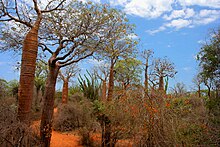Thorn forest

The woody vegetation in various arid regions of the world, characterized by thorn plants and succulents , is called thorn forest . The thorn forest in northeastern Brazil is called Caatinga .
Madagascar
In Madagascar, the southwest of the island, which faces away from the monsoons, is characterized by thorn-bush-succulent vegetation. The area covers a 50 to 100 km wide strip along the coast from Morondava to Tao Lanaro . The station Tuléar has an annual mean temperature of 24.2 ° C with an absolute minimum of 6.1 ° C, during the short summer rainy season an average of 344 mm of rain falls. However, the precipitation falls very irregularly, so that no shrub savannah can develop. The sometimes long periods of drought prevent grasses from growing.
A characteristic plant family is the Didiereaceae family , endemic to this area , which forms 10 to 15 m high woody plants. These deciduous, slightly succulent wood plants grow shrub-like when young, later throw off the lower branches and grow tree-like. Under the Didiereaceae there is a layer of bushes about 3 m high, which is formed by succulent Euphorbia species and other succulents. In addition to euphorbias of the Tirucalli section, these are representatives of the genera Aloe , Kalanchoe and Crassula and succulent cucurbits ( Xerosicyos , Seyrigea ). Bottle trees of the species Moringa drouhardi and Adansonia madagascariensis and Pachypodium lamerei are other typical representatives of the thorn forest. Characteristic features of the plants are thorns , cladodies , phyllocladia , microphylly or leaflessness.
In the thorn forest there are also a number of poikilohydric vascular plants , such as Selaginella nivea , ferns such as Notholaena , Peltaea , Doryopteris and representatives of the Velloziaceae ( Xerophyta ).
India
A narrow strip, especially in the dry, western part of the southern flank of the Himalayas up to 1000 m above sea level, is covered with a subtropical hard leaf or thorn forest ( Subtropical dry evergreen forest ). It is a low-growing, open wood composed of evergreen, shrub-like wood plants and low-growing trees. Many species are armed with thorns. During the summer monsoon season , grasses and herbs appear in the undergrowth. Characteristic representatives are Chrysopogon , Cymbopogon , Heteropogon (all Poaceae ), Olecurpida and Acacias .
supporting documents
- H. Walter, S.-W. Breckle: Ecology of the Earth. Volume 2: Special ecology of the tropical and subtropical zones. 3rd edition, Elsevier, Munich 2004. ISBN 3-8274-0789-3 . P. 289f (Madagascar), p. 306 (India)
